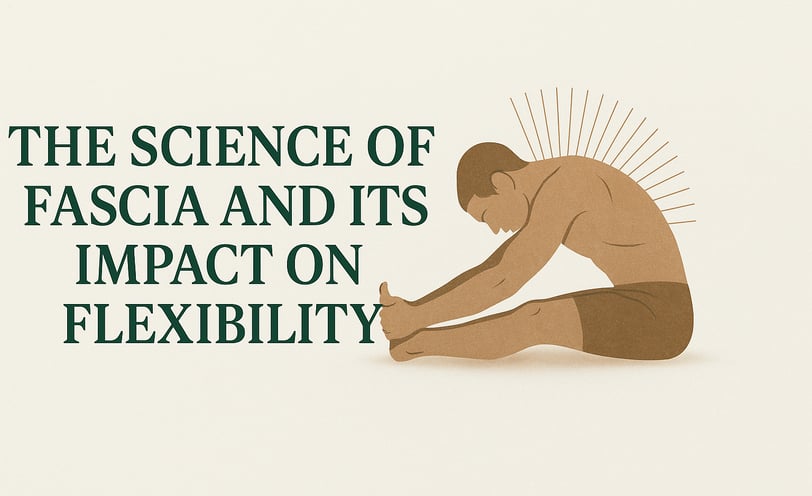The Science of Fascia: Unlocking True Flexibility Through Connective Tissue
Explore how fascia influences flexibility, movement, and recovery. This deep dive breaks down the latest research on connective tissue and how to optimize it through training, hydration, and mobility work.
6/5/20254 min read


The Science of Fascia and Its Impact on Flexibility
When most people think about flexibility, their minds jump to muscles and joints. But there’s another powerful player involved that often gets overlooked: fascia. Fascia is a connective tissue that weaves through and around muscles, bones, nerves, and organs. For years, it was viewed as passive packing material. Today, researchers are finding that fascia plays an active and essential role in movement, performance, recovery, and yes — flexibility.
What Exactly Is Fascia?
Fascia is a continuous web of collagen-rich connective tissue that wraps around nearly every structure in the body. Think of it as an internal bodysuit that provides support and shape, while also transmitting force across the body. It consists of densely packed protein fibers and fluid, and it comes in several layers — from the superficial fascia just under the skin to the deep fascia surrounding muscles and bones.
Its composition allows it to adapt and respond to movement, hydration levels, stress, and injury. When healthy and hydrated, fascia is supple and glides smoothly with muscles. When dehydrated or underused, it can become stiff, sticky, and restrictive.
Fascia and Flexibility: The Missing Link
Traditionally, flexibility training has focused on lengthening muscles. But fascia can restrict movement even when muscles are compliant. Fascia is highly adaptable to mechanical forces, meaning it responds to both movement and immobility. If you sit for long periods, your fascia may stiffen to reinforce that stationary position. Similarly, chronic stress can cause the fascia to tighten and reduce range of motion.
A 2014 study published in the Journal of Bodywork and Movement Therapies revealed that targeted fascial release techniques significantly improved range of motion more than static stretching alone. This suggests that to fully improve flexibility, we need to target both the muscles and the fascia.
Myofascial Chains and Whole-Body Movement
One of the most important discoveries about fascia is how it functions in interconnected chains. Rather than working in isolation, fascia connects different parts of the body along myofascial lines. The superficial back line, for example, connects the plantar fascia under your feet all the way to your eyebrows.
This explains why tight hamstrings can cause tension in your neck, or how ankle mobility can influence posture. Training fascia through whole-body movements like dynamic stretches, spiraling movements, and multidirectional resistance training can unlock these chains and improve total-body flexibility.
Hydration and Fascia Health
Fascia is made up largely of water, and its elasticity and glide depend on being well-hydrated. But drinking water alone isn’t enough. Movement acts like a pump, helping water flow into fascia-rich areas. That’s why frequent movement throughout the day is just as critical as drinking fluids.
If you’re consistently active, especially in the mornings when fascia tends to be stiff, your tissue stays more pliable and better equipped to adapt to physical demands. This is where tools that promote fascial hydration and circulation can help.
Try incorporating this collagen supplement to support your body's production of fascia-building proteins. Collagen is a major component of connective tissue and can improve the elasticity of fascia with regular use.
The Role of Stress and the Nervous System
Fascia is also tied closely to your nervous system. It contains numerous sensory receptors — some researchers estimate it may even be more innervated than muscle tissue. That means it can react to emotional and mental stress by tightening, creating restrictions that go beyond just physical strain.
This also explains why practices like yoga, breathwork, and meditation can indirectly improve mobility. They calm the nervous system, which helps the fascia soften and become more responsive to movement.
Consider using a guided mobility app that combines mindfulness and movement. These structured routines can help reinforce consistent, nervous-system-friendly flexibility habits.
Training Fascia Through Elastic Recoil
Fascia stores and releases elastic energy — much like a spring. This gives athletes their bounce, fluidity, and quick change of direction. Training fascia for its elastic properties means going beyond long static holds. Think plyometrics, bouncing drills, loaded carries, and rhythmic movements like skipping or kettlebell swings.
This doesn’t mean you should abandon traditional stretching, but supplementing your routine with elastic recoil work can make a huge difference in functional flexibility. It’s also why elite athletes focus so much on agility and fascia-friendly movement patterns. You might benefit from using a resistance band set to target dynamic tension and joint range in a fascia-supportive way. These tools allow you to layer movement patterns and stimulate the entire chain instead of isolating single muscles.
Recovery and Fascia Remodeling
Fascial tissue takes longer to heal than muscle, which is why overtraining or skipping rest days can backfire. Techniques like contrast therapy (hot/cold), massage, or even slow walks after training can support the recovery of fascial networks. Sleep is equally crucial. Most of the tissue remodeling and hydration exchange occurs during deep sleep cycles. Incorporating diverse movement, structured rest, and recovery tools will help your fascia adapt properly over time. Fascia thrives on variability. The more movement variety you feed it, the more flexible and resilient it becomes.
Final Take
Flexibility isn’t just about stretching muscles. It’s about addressing the entire system that surrounds and supports those muscles — and fascia is at the heart of that system. Whether you're chasing athletic performance, pain relief, or just better mobility as you age, giving fascia the attention it deserves can completely shift your training results.
Hydrate well, move often, breathe deep, and vary your routine. Your fascia will thank you, and your flexibility gains will last far longer than any single stretch routine ever could.
FITNESS
Nutrition
WellnesS
info@movebetterco.com
© 2025. All rights reserved | Privacy Policy | Terms & Conditions